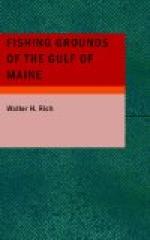The Spanish navigators who followed Gomez, in describing these coasts, when indicating this gulf, usually named it in honor of Gomez, the first of their nation to make a careful survey of its shores. Thus it became known as the Arcipelago de Estevan Gomez, and the mainland behind it as La Tierra de Gomez. It was so named on the map of Ribero in 1529 who thus acknowledged the source of his information.
The Biscayans followed Gomez but later gave way to the French fishermen, who followed down the chain of banks extending southward from the Grand Bank and entered these waters by way of Cape Sable. These gave to it the name Gulf of Norumbega or Sea of Norumbega. The name Norumbega was for a time applied to the coast lands and to the inland country stretching away indefinitely westward and northwestward from the waters of the gulf.
Later, with the coming of the English and the establishment of their colony in Massachusetts, the title Massachusetts Bay came into general use, although this name was afterwards restricted to the smaller section of the gulf at present so termed.
The charter of Gorges (in April, 1639) designated the territory deeded to him as the Province or County of Maine,[4] whence, perhaps, the modern custom of referring to these waters as the Gulf of Maine may have arisen. This latest name seems especially appropriate, in view of the fact that the present State of Maine lying directly opposite its entrance capes, stretches along the inner borders of the gulf and with its deeply indented shore line occupies by far the greatest section of its coasts. Thus the title has finally come into general use and acceptance in modern times. Apparently it was first officially proposed and used by the Edinburgh Encyclopedia in 1832 [5] and later was adopted by the United States Coast Survey.
[Footnote 4: “All that parte, purport and porcion of the Mayne Land of New England, we doe name, ordeyne and appoynt shall forever hereafter bee called and named The Province and Countie of Mayne.”]
[Footnote 5: Edinburgh Encyclopedia, Philadelphia edition, by Thomas Parker, Vol. XVIII, p. 263.]
DESCRIPTION
A very striking and peculiar body of water is this Gulf of Maine, markedly different in character from any other of the bays on the coast line of the eastern United States. Especially does it differ in the depth of its coastal waters, where in all the others, except the much smaller New York Bay, the shoal water is found extending far out from the land.
In the Gulf of Maine, however, with the single exception of the vicinity of Ammens Rock on the eastern part of Cashes Bank, the entire central area presents navigable deep water having a mean depth of 100 fathoms, out of which rise the various underwater plateaus, whose depths average about 50 fathoms and which constitute the larger of the fishing grounds. In addition to these, many smaller banks and “fishing spots” are found nearer the land where they lie a along the 50-fathom curve.




